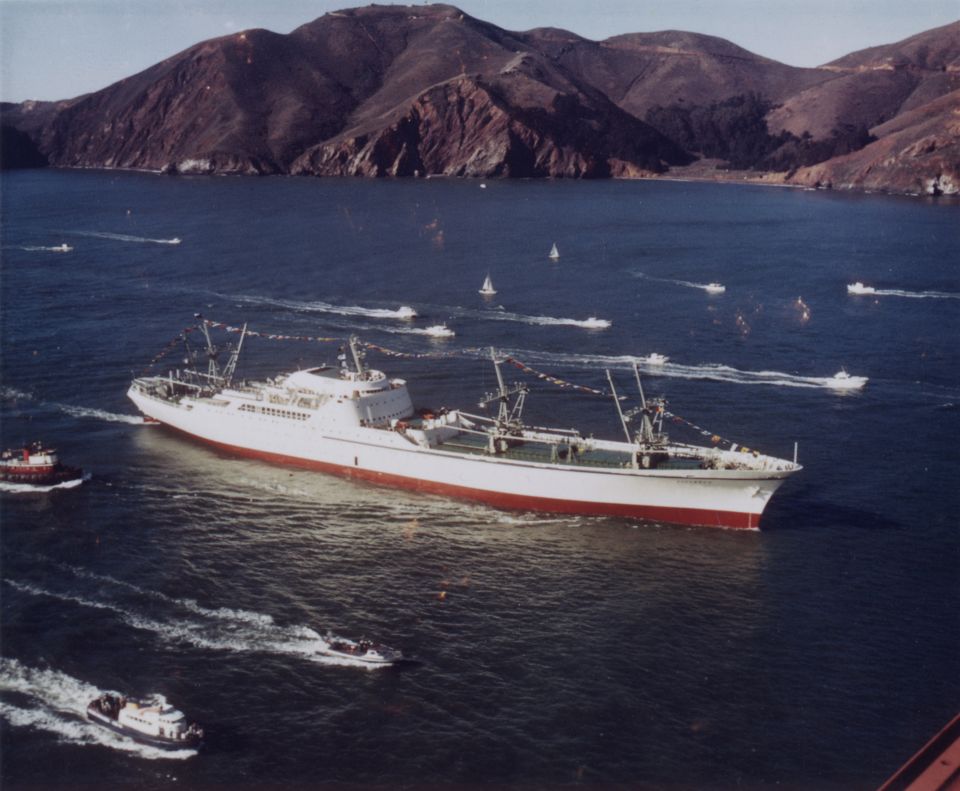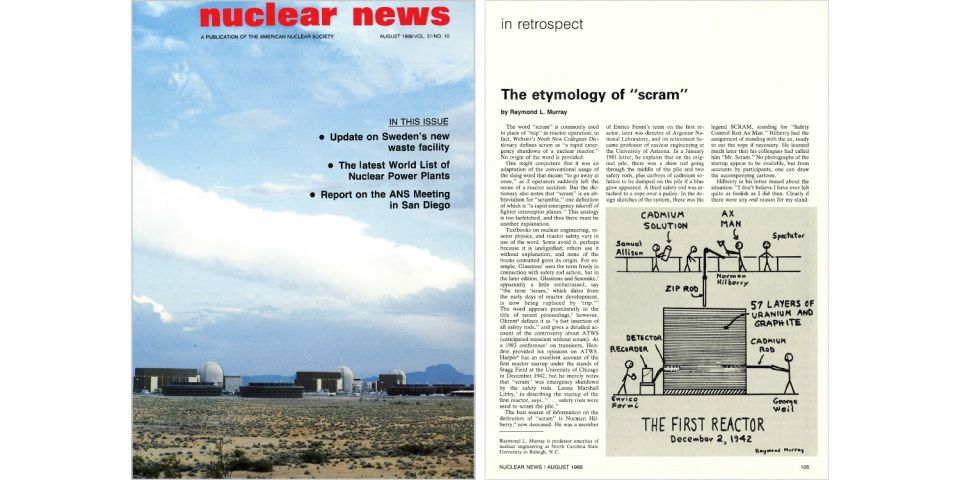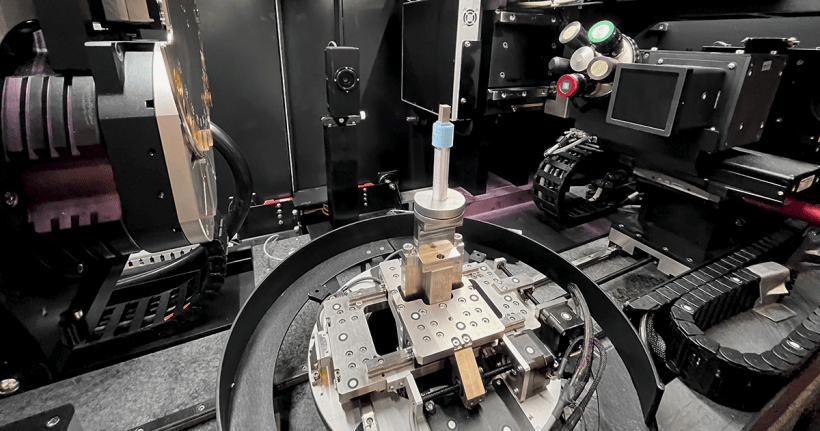Past, Present, and Promise 3: Return to the NS Savannah
Previous articles in this series were published on November 8 and November 14; this is the third and final installment of the series, which concludes just prior to the 60th anniversary of President Eisenhower's famous "Atoms for Peace" speech. That speech, whose official title was "Atomic Power for Peace," was delivered to the General Assembly of the United Nations on December 8, 1953 and its ramifications for the future of civil nuclear energy the world over were immense.
November 14, 2013-This was the day on which I was to see my old friend again, the nuclear-powered passenger and cargo ship NS Savannah, after 20 years. As about 30 American Nuclear Society members boarded the bus at the Omni Shoreham Hotel in Washington D.C. on the afternoon of that day, I wondered how many of them had ever seen the ship before, or had a similar personal connection with it.
On arrival, to say that I found the ship better than I'd left it would be a supreme understatement; she's in absolutely wonderful shape in comparison; although, frankly, there is yet major work to be done. The ship seems for now to be in no imminent threat for disposal; according to Erhard Koehler, who administrates the Savannah for the U.S. Maritime Administration, an annual budget of about $2 million keeps the ship docked and maintained (sales of souvenir items on board also benefit the ship). The ship is stipulated, legally, to be decommissioned by 2031, which simply means that the primary nuclear plant components must be removed and disposed of, and doesn't mean the ship will be scrapped-but as we have seen, the federal government does not always adhere to its own laws (Yucca Mountain, anyone?). So, this deadline being a "hard" line seems pretty unlikely. The problem in getting this done, Koehler told us while we were assembled in the Eisenhower Room on board the ship, is that eventually the Congress must budget money to do it-and it never comes.
What does come are visitors. People who are curious, or "nukes" who want to see the storied ship, or even people like me who have some sort of past attachment to the ship. The ship is opened at least once a year on Maritime Day for the public, and arrangements can be made for tour groups to visit the ship as well. The NS Savannah may not be as easily visible today as she was while she was at Patriot's Point in South Carolina in the 1980s and early 1990s, but she's in better waters, we might say-with dedicated caretakers, secure funding for upkeep, and more than a skeletal plan for the future.
What follows is a photographic tour of the ship. Photos for this piece were taken by myself and by ANS's Paul Bowersox, who accompanied me on this tour. I've placed them in the order in which they were taken, duplicating our tour route throughout the ship. My observations are included in the captions and following the photo-essay. Please remember to click on the photos to enlarge them; some will be quite large and spectacular when clicked.
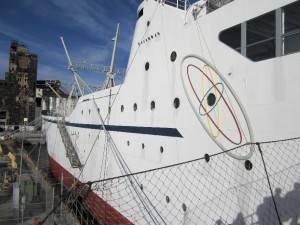 The NS Savannah is docked at a pier location that is largely blocked from view by land by a giant grain elevator. This view shows the port side of the ship from the gangway leading to the passenger reception area. (Photo for ANS by Paul Bowersox)
The NS Savannah is docked at a pier location that is largely blocked from view by land by a giant grain elevator. This view shows the port side of the ship from the gangway leading to the passenger reception area. (Photo for ANS by Paul Bowersox)The NS Savannah is docked at a pier location that is largely blocked from view by land by a giant grain elevator. This view shows the port side of the ship from the gangway leading to the passenger reception area. (Photo for ANS by Paul Bowersox)
One accesses the ship the same way that she was accessed when in service; via a brow leading up to the original reception area. This area was never open to the public during the time span 1981-1994 when the ship was at Patriots Point, when access to the ship was via a side opening.
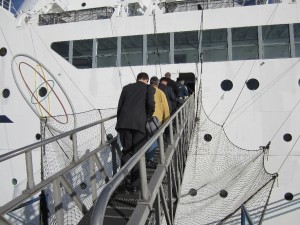 Some of the contingent from the American Nuclear Society climbing up to the NS Savannah. (Photo for ANS by Paul Bowersox)
Some of the contingent from the American Nuclear Society climbing up to the NS Savannah. (Photo for ANS by Paul Bowersox)Some of the contingent from the American Nuclear Society climbing up to the NS Savannah. (Photo for ANS by Paul Bowersox)

Maritime Administration 'Visitor' badges were issued at the original purser's desk location inside the passenger lobby, which features a spectacular original piece of furniture. (Photo for ANS by Will Davis)
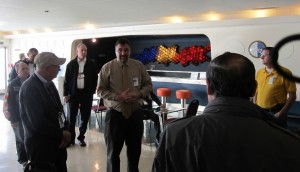 Erhard Koehler, administrator of the NS Savannah for the US Maritime Administration, addresses the assembled visitors. He is flanked by Larry Kenworthy (left, wearing ball cap) and Francis "Bucky" Owens (right, yellow shirt) who led the two tour groups around the ship. Both Kenworthy and Owens were reactor operators on the Savannah. (Photo for ANS by Paul Bowersox)
Erhard Koehler, administrator of the NS Savannah for the US Maritime Administration, addresses the assembled visitors. He is flanked by Larry Kenworthy (left, wearing ball cap) and Francis "Bucky" Owens (right, yellow shirt) who led the two tour groups around the ship. Both Kenworthy and Owens were reactor operators on the Savannah. (Photo for ANS by Paul Bowersox)Erhard Koehler, administrator of the NS Savannah for the US Maritime Administration, addresses the assembled visitors. He is flanked by Larry Kenworthy (left, wearing ball cap) and Francis "Bucky" Owens (right, yellow shirt) who led the two tour groups around the ship. Both Kenworthy and Owens were reactor operators on the Savannah. (Photo for ANS by Paul Bowersox)
 This is the Veranda/Cocktail Bar area, the public (passenger) bar/lounge on the NS Savannah. The lighted, sculptured wine rack behind the bar is meant to be a representation of the trilinear table of the elements, and is one of many striking decorative features in this space. A glass bulkhead looks aft from this space over the former swimming pool and shuffleboard areas. (Photo for ANS by Will Davis)
This is the Veranda/Cocktail Bar area, the public (passenger) bar/lounge on the NS Savannah. The lighted, sculptured wine rack behind the bar is meant to be a representation of the trilinear table of the elements, and is one of many striking decorative features in this space. A glass bulkhead looks aft from this space over the former swimming pool and shuffleboard areas. (Photo for ANS by Will Davis)This is the Veranda/Cocktail Bar area, the public (passenger) bar/lounge on the NS Savannah. The lighted, sculptured wine rack behind the bar is meant to be a representation of the trilinear table of the elements, and is one of many striking decorative features in this space. A glass bulkhead looks aft from this space over the former swimming pool and shuffleboard areas. (Photo for ANS by Will Davis)
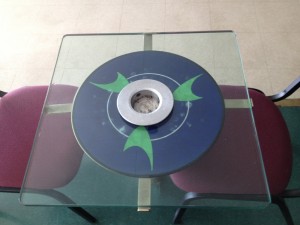
The tables in the cocktail bar area, which are original, display a wonderful "modernistic" motif right out of the 1958-1961 period during which the ship was designed and built. These tables were originally lighted internally, so that the lexan table tops provided a glow. This space made extensive use of indirect lighting. (Photo for ANS by Will Davis)
The original tour brochure for the ship states that the overall design was the responsibility of George C. Sharp, Inc. As to the veranda/cocktail bar, "the veranda is carefree, open and light in feeling to suit daytime gatherings as well as evening festivity." There is no question that the ship was built as a 'showboat,' albeit a completely functional one.
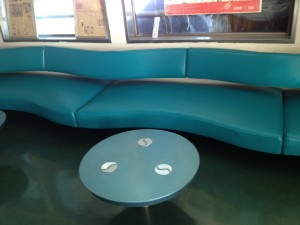
The starboard side (right side for landlubbers!) of the cocktail lounge area is bordered by large windows and this attractive seating area. A passageway leads along the starboard side forward to what used to be called the Main Lounge, and is now the Eisenhower Room. (Photo for ANS by Will Davis)
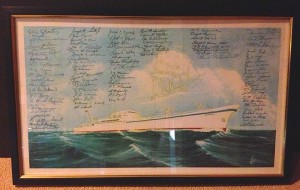 The NS Savannah is simply full of wonderful artifacts - there wasn't time to see them all, and some aren't even yet properly mounted or labeled. One such item was this print signed by the crew, which was spotted leaning against a podium in the Eisenhower Room. (Photo for ANS by Will Davis)
The NS Savannah is simply full of wonderful artifacts - there wasn't time to see them all, and some aren't even yet properly mounted or labeled. One such item was this print signed by the crew, which was spotted leaning against a podium in the Eisenhower Room. (Photo for ANS by Will Davis)The NS Savannah is simply full of wonderful artifacts - there wasn't time to see them all, and some aren't even yet properly mounted or labeled. One such item was this print signed by the crew, which was spotted leaning against a podium in the Eisenhower Room. (Photo for ANS by Will Davis)
 The tour visits the bridge of the Savannah. The ship's control console is at right, under the bridge windows, with the right most device on the upper section being the engine order telegraph, and the device to the left of it being the shaft RPM indicator. The ship's wheel is just out of view on the left of the photo. (Photo for ANS by Paul Bowersox)
The tour visits the bridge of the Savannah. The ship's control console is at right, under the bridge windows, with the right most device on the upper section being the engine order telegraph, and the device to the left of it being the shaft RPM indicator. The ship's wheel is just out of view on the left of the photo. (Photo for ANS by Paul Bowersox)The tour visits the bridge of the Savannah. The ship's control console is at right, under the bridge windows, with the right most device on the upper section being the engine order telegraph, and the device to the left of it being the shaft RPM indicator. The ship's wheel is just out of view on the left of the photo. (Photo for ANS by Paul Bowersox)
The Engine Order Telegraph is used to transmit the desired ship's speed from the bridge to the power plant. Perhaps as an expression of hope for the ship's future, the telegraph is presently rung up Ahead Full.

View directly forward out of the bridge windows, over the ship's wheel. (Photo for ANS by Paul Bowersox
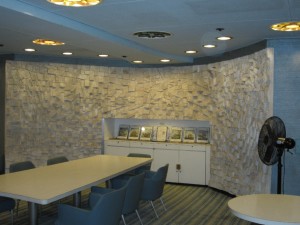
The after end of the Main Dining Room on "B" Deck. The Captain's Table is seen, with the original sculptured wall art which is meant to depict fission. If one looks carefully, splitting atoms and straight lines of flight of emitted particles can be made out. This is one of the most impressive spaces on the ship, and is almost entirely still original. (Photo for ANS by Paul Bowersox)

All of the overhead light fixtures in the main dining room incorporate a wonderful atom motif. (Photo for ANS by Paul Bowersox)
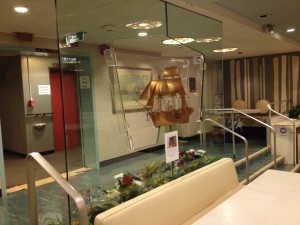 Entryway into the Main Dining Room. A wonderful original depiction of the SS Savannah, first ship to cross the Atlantic with aid of steam power in 1819 and after which NS Savannah is named, is visible in the glass partition. To the left in the photo is the passageway to the passenger elevator and passenger stairwell. These are forward of the dining room. Passage to the ship's galley is to the right of the painting seen mounted on the bulkhead. (Photo for ANS by Will Davis)
Entryway into the Main Dining Room. A wonderful original depiction of the SS Savannah, first ship to cross the Atlantic with aid of steam power in 1819 and after which NS Savannah is named, is visible in the glass partition. To the left in the photo is the passageway to the passenger elevator and passenger stairwell. These are forward of the dining room. Passage to the ship's galley is to the right of the painting seen mounted on the bulkhead. (Photo for ANS by Will Davis)Entryway into the Main Dining Room. A wonderful original depiction of the SS Savannah, first ship to cross the Atlantic with aid of steam power in 1819 and after which NS Savannah is named, is visible in the glass partition. To the left in the photo is the passageway to the passenger elevator and passenger stairwell. These are forward of the dining room. Passage to the ship's galley is to the right of the painting seen mounted on the bulkhead. (Photo for ANS by Will Davis)

Original seating down the port side of the dining room. The carpet is original. Historic photos showing the exact original appearance of this and other spaces are placed around this, and other, spaces in the ship, as some features are no longer perfectly original. (Photo for ANS by Will Davis)
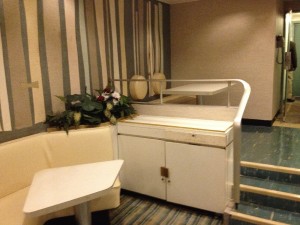
Either side of the foyer leading to the dining room is an interesting "two top" table, with button style vinyl seat backs affixed to the bulkhead. (Photo for ANS by Will Davis)

A display case in the dining room contains original servingware from the ship, complete with atom motif. (Photo for ANS by Will Davis)
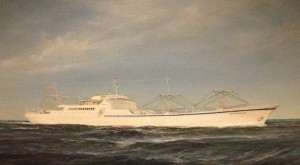 Painting depicting NS Savannah, foyer of Main Dining Room. (Photo for ANS by Will Davis)
Painting depicting NS Savannah, foyer of Main Dining Room. (Photo for ANS by Will Davis)Painting depicting NS Savannah, foyer of Main Dining Room. (Photo for ANS by Will Davis)
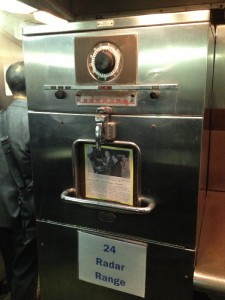
This is the most interesting piece of equipment in the ship's galley - the RADARANGE. (Photo for ANS by Will Davis)
The NS Savannah put to sea with one of the very earliest available microwave ovens. This oven carries the brand name "RadaRange" clearly on the front-and we were told on the tour that Amana, the company with whom this brand name is associated, was a division of Raytheon Corporation (well-known as a provider of radar equipment for both commercial and Navy ships.) It's interesting to note, however, that this particular microwave oven says "Amana" nowhere on it, but only says "Raytheon" in an oval-shaped emblem seen further down the front of the oven.
This oven has two interesting features. First, it is water-cooled; water cooling piping runs from the overhead down to, and back from, the oven inboard (and just out of view here.) Second, the oven had no safety shutoff interlock on its door; the oven could run with the door open. The output of the oven was not stated, but given its size and the fact that the timer runs up to 21 minutes, it cannot be high compared to today's appliances.
The rest of the galley was indeed fascinating-the ship's fittings were extensive and elaborate, even to the point of including a separate butcher's shop.
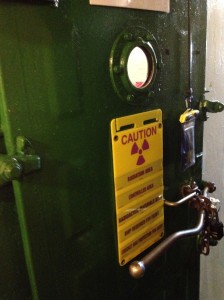
After exiting the galley and viewing some crew spaces, we found, in an athwartships passageway, the first "real" nuclear component on the ship; the entry door to the reactor plant containment. (Photo for ANS by Will Davis)
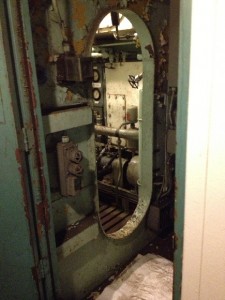
The ship still needs help - many areas are not fully restored. We passed an open door, which our guide informed us led to the control rod drive hydraulic pump room. (Photo for ANS by Will Davis)
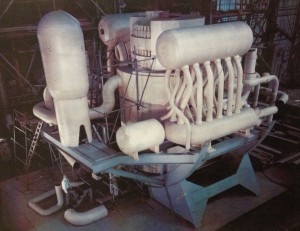 This is a photograph of a photograph. New York Shipbuilding constructed a complete but non-operative mockup of the Savannah's PWR reactor plant to test for access and clearance. The mockup was scrapped years ago. (Photo for ANS by Will Davis)
This is a photograph of a photograph. New York Shipbuilding constructed a complete but non-operative mockup of the Savannah's PWR reactor plant to test for access and clearance. The mockup was scrapped years ago. (Photo for ANS by Will Davis)This is a photograph of a photograph. New York Shipbuilding constructed a complete but non-operative mockup of the Savannah's PWR reactor plant to test for access and clearance. The mockup was scrapped years ago. (Photo for ANS by Will Davis)
In the illustration above, it's clear that the NS Savannah used an early style of steam generator like that found at the Shippingport Atomic Power Station and at Indian Point Unit 1, with separate (lower) heat exchanger sections and upper steam drum sections connected by riser and downcomer pipes. Two steam generators (one for each loop) are visible here. The reactor of course is at center, and the tall vessel at left is the pressurizer.
Each of the steam generators was rated to deliver 136.5 million BTU per hour at full rated reactor power, with shells, heads, and tubes made of 304 stainless steel. The pressurizer (which as its name implies pressurizes the primary coolant system to prevent boiling) had 160 cartridge type replaceable heaters, with a total heat capacity of 224 kw. The maximum heatup rate allowed was 75F/hr. This vessel was also made of 304 stainless steel.
The reactor was rated 80 MWth, and contained 8050 kg of uranium dioxide, enriched to 4.2% U-235 (inner 16 elements) or 4.6% U-235 for a total U-235 load of 312 kg. The fuel pellets were contained in 304 stainless tubes, with an active height of 66 inches. Each element had 164 of these rods and was 8.5 inches square; 32 fuel elements total made up the reactor. Twenty-one control rods, made up of boron stainless steel and Zircaloy-2 followers all clad with 304 stainless, were fitted. The designed core life was 40,000 megawatt-days, or 700 days at an actual average power of 63.5 MWth. The plant did not operate with boron poison in solution in the primary coolant, although provision for emergency boron injection for shutdown was installed.
(Information above from "NS Savannah Technical Specifications, May 1964-NS Savannah Technical Staff/Babcock & Wilcox-Todd Shipyards" in Will Davis collection.)

One of the most memorable features of the ship is the provision of a gallery deck surrounding the engine room. The inboard side of this three-sided gallery contains windows looking down while the outboard side features many illustrations of the power plant and its workings. (Photo for ANS by Will Davis)
In the photograph above, at the bottom we see (with black handwheels) the throttle box of the high pressure ahead steam turbine; the Savannah used compound turbines, in which steam drives first a high pressure and then a low pressure turbine. The drive pinion mounted to this turbine contacts an intermediate gear inside the rounded yellow housing seen a bit further away; on the end of the pinion housing as a green 750 HP electric motor, called the "Take Home motor" that can propel the ship at roughly 6 knots should steam from the reactor plant be unavailable. (The Savannah has two 12 cylinder Electro-Motive 567 series diesel engines that we today would call EDG's or Emergency Diesel Generators, which would provide emergency power for this motor and ship's loads if required. Each diesel was rated 750 KW or about 1000 HP.)
 This spectacular photo clearly depicts the control room at the after end of the NS Savannah's engine room. Click to enlarge. (Photo for ANS by Paul Bowersox)
This spectacular photo clearly depicts the control room at the after end of the NS Savannah's engine room. Click to enlarge. (Photo for ANS by Paul Bowersox)This spectacular photo clearly depicts the control room at the after end of the NS Savannah's engine room. Click to enlarge. (Photo for ANS by Paul Bowersox)
The control room seen above, which was located at the after end of the Savannah's engine room, was the space from which the reactor was controlled and monitored. The control and indicating equipment seen here was the responsibility of Bailey Meter Co., Cleveland, Ohio, which had been a subsidiary of Babcock & Wilcox (which was the vendor for the nuclear power plant of the ship) since 1925. As announced in the October 1959 issue of Nucleonics, this control and indication equipment for the Savannah included "20 flow indicators, 15 level indicators, 45 pressure indicators, 35 temperature indicators, 55 meters, 31 valve selector switches, 60 selector switches and 120 push buttons" and had a total of over 480 control and indicating devices. A complete simulator, using a duplicate of this control panel, was built by Westinghouse and fitted with an analog computer including 54 switches to enable "simulations of various malfunctions." That simulator was eventually installed at a training facility at Lynchburg, Virginia. (Nucleonics, October 1959, copy in Will Davis collection.)
The turbines and reduction gears, products of DeLaval Steam Turbine Company, were rated for a maximum 22,000 SHP ahead, and 8000 SHP astern using saturated steam variable from 430-700 psia. The turbines had interstage moisture extraction to prevent erosion. The ship also had two 1500 KW steam turbine generators, not shown. (Technical Specifications, NS Savannah and Nucleonics, October 1959.)
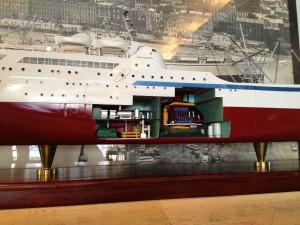
Returning to the cocktail lounge, we found time to buy souvenirs, and to examine this fantastic model of the ship, with an accurate depiction of the reactor plant and containment. (Photo for ANS by Will Davis)
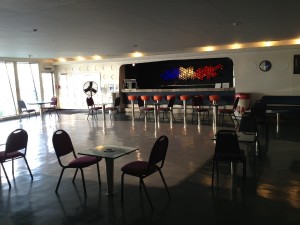
This lounge, with its distinctive bar, is an absolutely unforgettable space. (Photo for ANS by Will Davis)
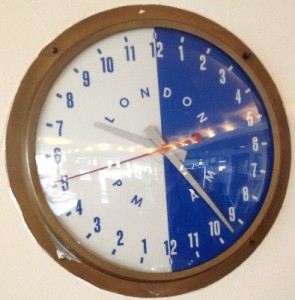
Distinctive time-zone clocks, not all of which have survived, line part of the bulkhead by the bar. (Photo for ANS by Will Davis)
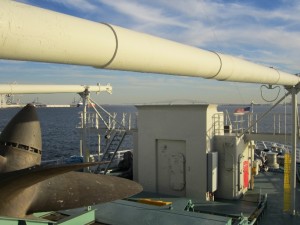 A look over the stern of the NS Savannah. The ship's screw can be seen on deck; the ship has been completely disabled, and the screw and main reduction gear were removed. (Photo for ANS by Paul Bowersox)
A look over the stern of the NS Savannah. The ship's screw can be seen on deck; the ship has been completely disabled, and the screw and main reduction gear were removed. (Photo for ANS by Paul Bowersox)A look over the stern of the NS Savannah. The ship's screw can be seen on deck; the ship has been completely disabled, and the screw and main reduction gear were removed. (Photo for ANS by Paul Bowersox)
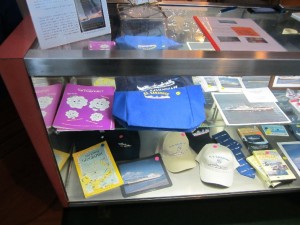
Many of us took advantage of the ship's well-stocked gift shop; these are only a few of the available items. (Photo for ANS by Paul Bowersox)
 The American Nuclear Society's tour group, along with some of the Savannah staff. (Photo courtesy Erhard Koehler)
The American Nuclear Society's tour group, along with some of the Savannah staff. (Photo courtesy Erhard Koehler)The American Nuclear Society's tour group, along with some of the Savannah staff. (Photo courtesy Erhard Koehler)
The feeling I had leaving the ship after several hours' worth of touring and photographing and talking can't be described. I had erased the old suppositions about what she might be like with real, new memories-and facts. The facts are that while the ship is in good hands, much more work is required to plan out the decommissioning and fund it. While the people involved are desperately dedicated to the ship, there just aren't enough of them. The fate of the ship doesn't so much presently hang in the balance, as it has a cloudy future; the funding per year is steady, but there are not sufficient accumulated funds to decommission the power plant in the legally binding time frame... although I've already given my impression on that mark.
Erhard Koehler spoke the most memorable quote of the day, even before most of the tour had commenced; he said to the assembled group that
"The Savannah here is really the only remaining, intact example of President Eisenhower's 'Atoms for Peace' program. For that reason alone, she needs to be preserved and cared for."
I could not agree more-and will do everything in my power in the future to aid those efforts.
I personally would like to thank the American Nuclear Society, the U.S. Maritime Administration, and the NS Savannah Association for setting up this tour and providing their support and information. Also, Paul Bowersox of ANS HQ staff provided an invaluable service during this pre-planned tour as photographer, ensuring that we'd have great shots.
I would like to finish this piece by adding something-there is a great deal of this ship not shown in this article. Many thousands of linear feet of passageway, many views topside and below, and many distinctive areas remain for visitors to see and explore should they tour the ship. This photo-essay in no way relieves anyone interested in the ship of a need to visit-and what's more, in most cases the photos don't do the ship justice. I personally encourage those with an interest in America's atomic history to find a way to visit the NS Savannah.
Recognition after Removal From Service:
•NS Savannah was given an American Nuclear Society Nuclear Historic Landmark Award in 1991.
•The ship was nominated to the National Register of Historic Places in 1981.
•The American Society of Mechanical Engineers named the ship as an International Historic Mechanical Engineering Landmark in 1983.
•The ship was named a National Historic Landmark by the U.S. Department of the Interior in 1991.
_____________________
 Will Davis is a consultant to, and writer for, the American Nuclear Society; an active ANS member, he is serving on the ANS Communications Committee 2013-2016. In addition, he is a contributing author for Fuel Cycle Week, is secretary of the Board of Directors of PopAtomic Studios, and writes his own popular blog Atomic Power Review. Davis is a former US Navy reactor operator, qualified on S8G and S5W plants. He's also an avid typewriter collector in his spare time.
Will Davis is a consultant to, and writer for, the American Nuclear Society; an active ANS member, he is serving on the ANS Communications Committee 2013-2016. In addition, he is a contributing author for Fuel Cycle Week, is secretary of the Board of Directors of PopAtomic Studios, and writes his own popular blog Atomic Power Review. Davis is a former US Navy reactor operator, qualified on S8G and S5W plants. He's also an avid typewriter collector in his spare time.
 Paul Bowersox works for the American Nuclear Society at its Chicago, Illinois, headquarters on staff where he manages social media. Although an avowed landlubber, he also holds in high regard those who go down to the sea in ships and do business in great waters.
Paul Bowersox works for the American Nuclear Society at its Chicago, Illinois, headquarters on staff where he manages social media. Although an avowed landlubber, he also holds in high regard those who go down to the sea in ships and do business in great waters.




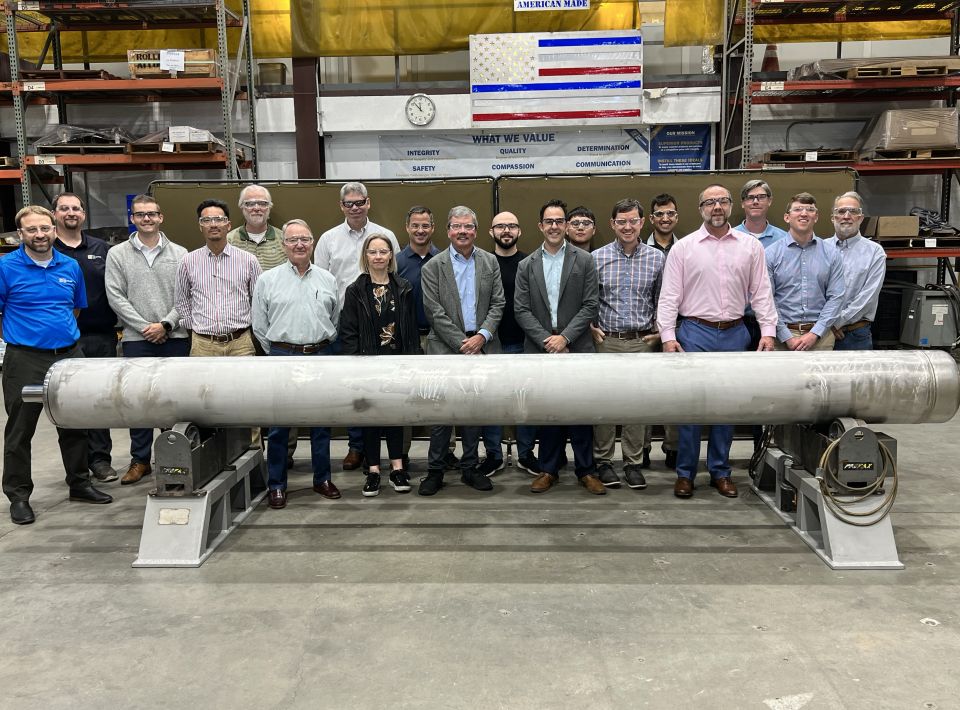 rotated.jpg)
